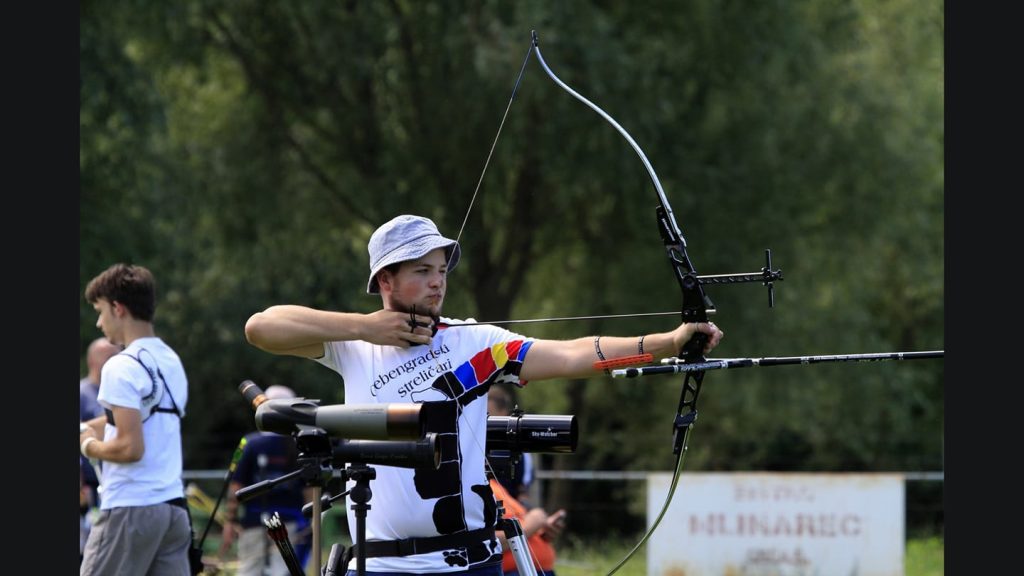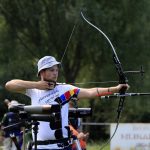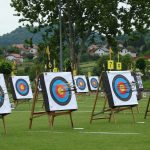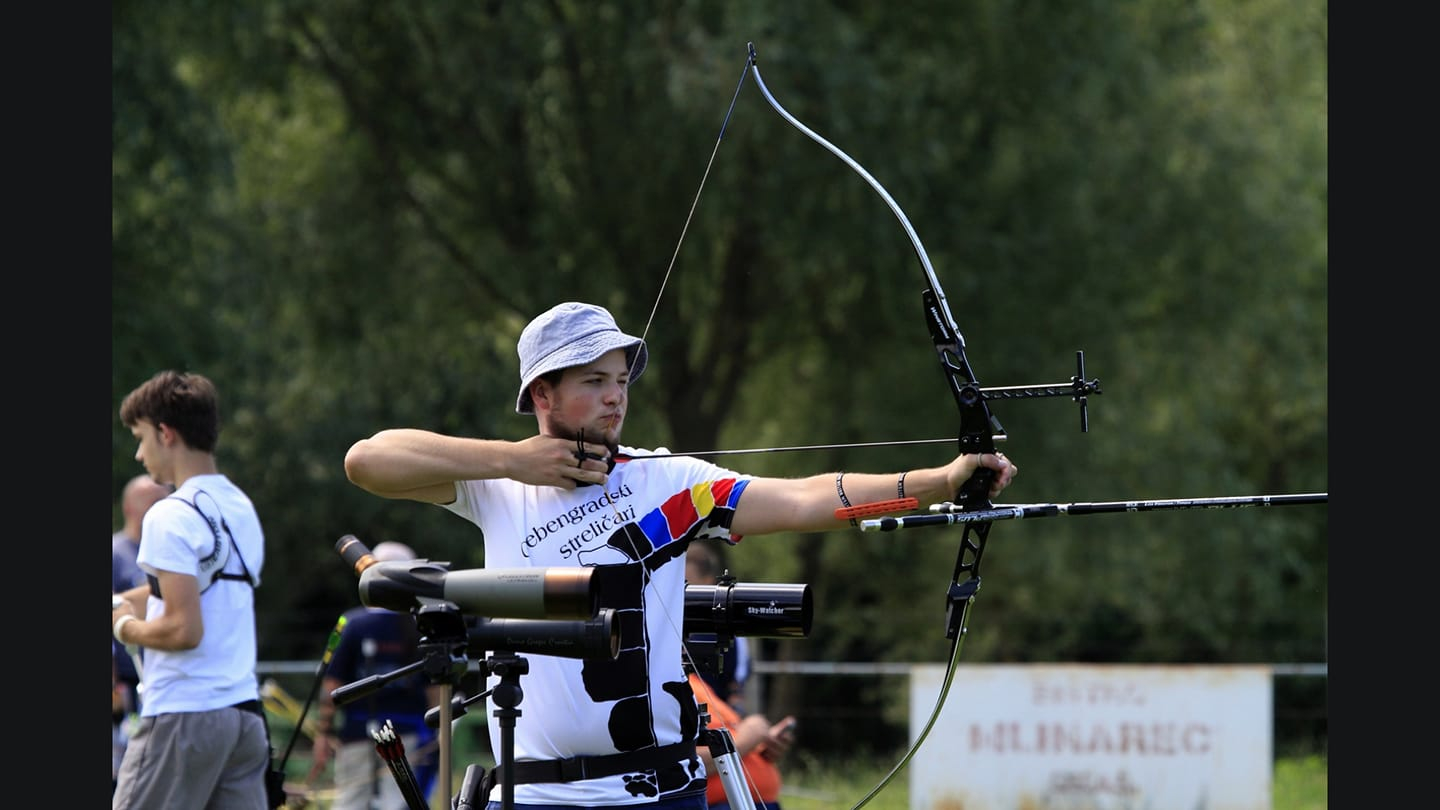
July 20, 2020 – Lovro Černi, a young archer from the Grebengradski streličari archery club, is defending Croatia’s colours in the national archery team after just three years in this sport. Stressful, prestigious, addictive – archery as it is and should be.
He was going to pick up his black and white, recurve bow one last time. Napoli’s huge sports hall fell silent as he was approaching the red marked shooting line. His sweaty hands picked one arrow with the bronze-colored feathers from the quiver. He nocked the arrow, took a look at target 18 metres away from him, and closed his eyes. Taking a deep breath, he pulled the string, and his raging heart caused him chest pain. The red colour of the numbers on the counter awoke the stress in him: ten seconds left. Still looking through his sight, he gently released the string from his fingers. With the release of the arrow, he closed his eyes. He didn’t want to see the shot, but the judge revealed the result in English with an Italian accent: “Lovro Černi won the shoot-off!”
After starting practicing archery out of curiosity at the Grebengradski streličari club in a small place in northern Croatia, this 16-year-old showed a great talent for this sport even back then at the beginning. Three years later, he received an official call by the Croatian Archery Association, offering him an invitation to join the national team. Napoli wasn’t the only place Lovro conquered. He was at international competitions in Nimes, Rome, and Mokrice. From the world cup to the European Field Championship in four years, Lovro got to experience life – and not only in the world of archery.
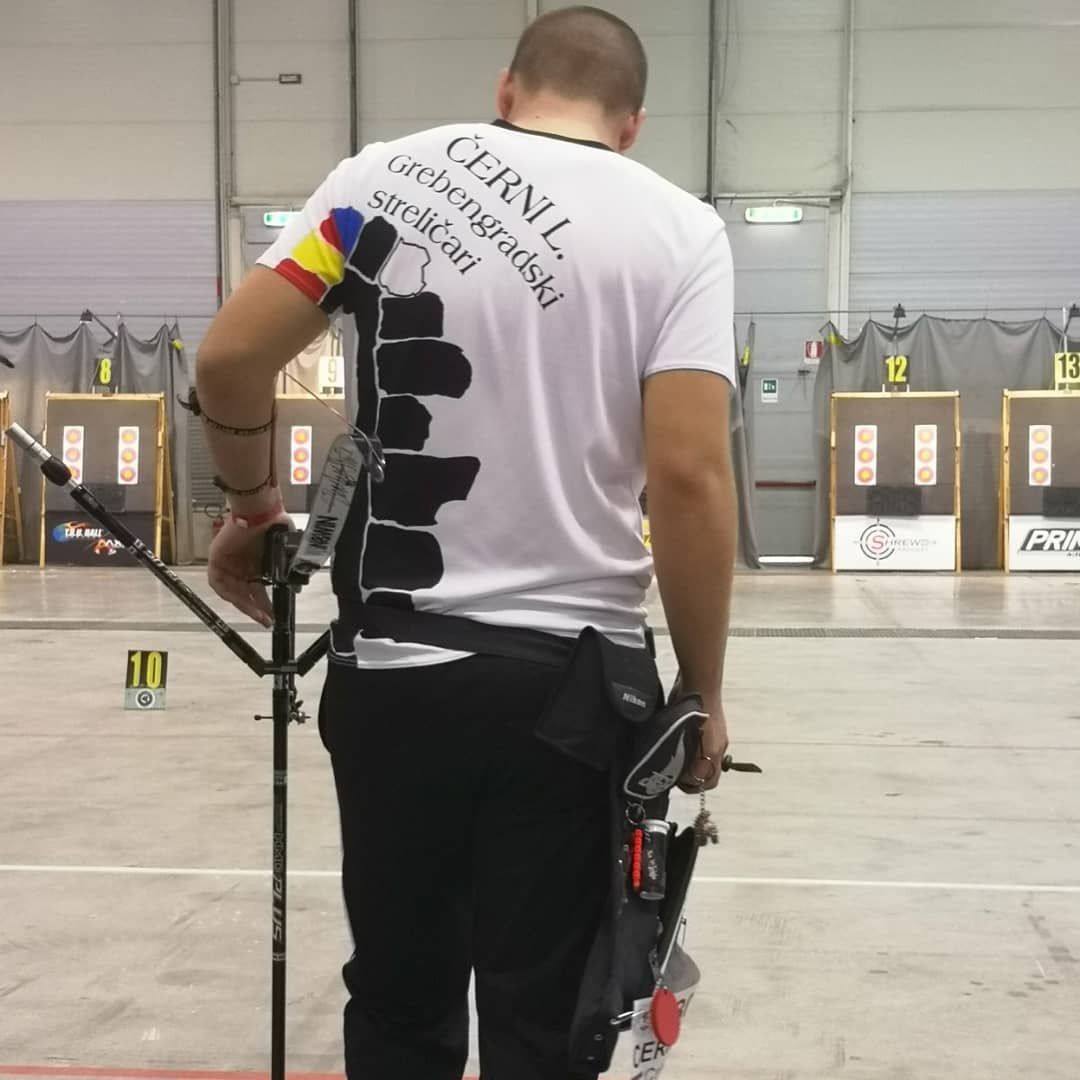
“My preparation for Universiade in Napoli did not require just archery skills,” his cynical smile made it clear that the arrangement wasn’t made as easy as one would think. Lovro and Ivan Horvat were the only ones who were chosen to represent Croatia out there. “The same coach was assigned to both of us, but this coach was biased, so… I didn’t know anything I should know; the coach was helping only Ivan.” It was up to Lovro to buy a plane ticket for this competition, and he figured this out just two weeks before the Universiade.
As Lovro didn’t get any help from his own coach, he contacted the main organiser from Split, Jelena Matešić, who was responsible for every sport in which Croatia was represented in Italy. “I was in contact with Jelena more than with this assigned coach.”
Their accommodation was in the student dorm, but as Lovro described, the whole city is a student city. There are all the colleges, students’ restaurants, and dorms. However, Lovro got the poorest combination of all of those. “There was no bathroom, there was a board on the toilet seat, and the food was genuinely bad – so sometimes we went to other athletes’ restaurants to get some proper food.” Some other athletes’ accommodation was a luxury cruiser with pools.
On the last evening of the Universiade, Lovro and Ivan managed to gather around 50 archers in the bar and get to know each other. “It was perfect – I was toasting the whole night with one Korean archer who didn’t understand a word of English,” said Lovro, scrolling through his phone’s gallery to find a group selfie. “Besides, Koreans aren’t robots, as we often imagine them in our heads. They are some really cool guys.”
On the very first competition for the national team in 2019 in Mokrice, Slovenia, their accommodation was in Terme Čatež. Even though it’s one of the most popular outdoor pools in this part of Europe, the contradiction was – if you are shooting, there’s no swimming for you. The warm water could overrelax their muscles and make shooting much harder and even painful for them.
This was a different type of competition called field archery. The 48 targets are placed all around the wood, and every one of them is placed at a different distance. They know the distance for only 24 targets; the other half is up to their abilities to figure out. After the qualifications, there are 24 more targets in the eliminations. The closest unknown distance is 10 metres, and the highest-pointed-middle is merely ping-pong ball-sized. To get six out of six points on the furthest, 55 metre-distanced target, an archer needs to hit a grapefruit-sized circle. For known distances, it goes 15 metres for the closest and 60 metres for the furthest.
“We don’t know the range for every target, and that’s the beauty of field archery – you have to estimate the range by yourself,” said Lovro, whose biggest challenge is shooting at a large angle of inclination. Targets can be lifted up in the air, in front of the river, or put across the valley.
Those situations, when archers are scared that they might just miss the whole target, can pull the trigger in target panic. It ‘ a psychical problem that doesn’t let the archer pull the string to its usual position. While an archer pulls the string, looking at the centre of the target [yellow colour], he is urged to release the arrow even if he is only half ready. An archer can take the perfect shot if the target is any other colour but yellow. A lot of them are beating target panic by aiming at the wall during training. Of course, they never release the arrow in such circumstances. They teach their muscles to remember the positions, so they can do the same in front of the actual target. Target panic is a serious problem that affects every archer – the only difference is that some manage to cope better with it than others do. A lot of people sadly even give up on this sport because of it.
Archers walk all day through the woods full of mosquitoes, who bite them at the moments when one move can cost them a dozen points. Estimating the distance and changing the parameters on sight right before they shoot, standing on bumpy terrain, is just one of several issues that come with field archery. One might think that the trees protect them from the sun, but hats and sun cream are also must-have parts of an archer’s equipment.
“But it’s the adrenaline that bothers us the most. At this European Championship, I won 4th place, and only a few points made the difference,” said Lovro. Every point archers lose, can be crucial for their ranking. “I remember how, in the final shoot, my opponent and I shot almost at the same place, but my arrow was maybe 2 centimetres closer to the middle. I couldn’t see it properly, but my coach and my friends, who were watching the target through the binoculars, starting yelling and celebrating.” He turned around and saw his coach applauding and showing his two thumbs up, above his head. Lovro smiled back and raised his bow up in the air, which is every archer’s move after winning a match. “I was glad that Zoki didn’t come for nothing, you know. I was happy I could make him proud.”
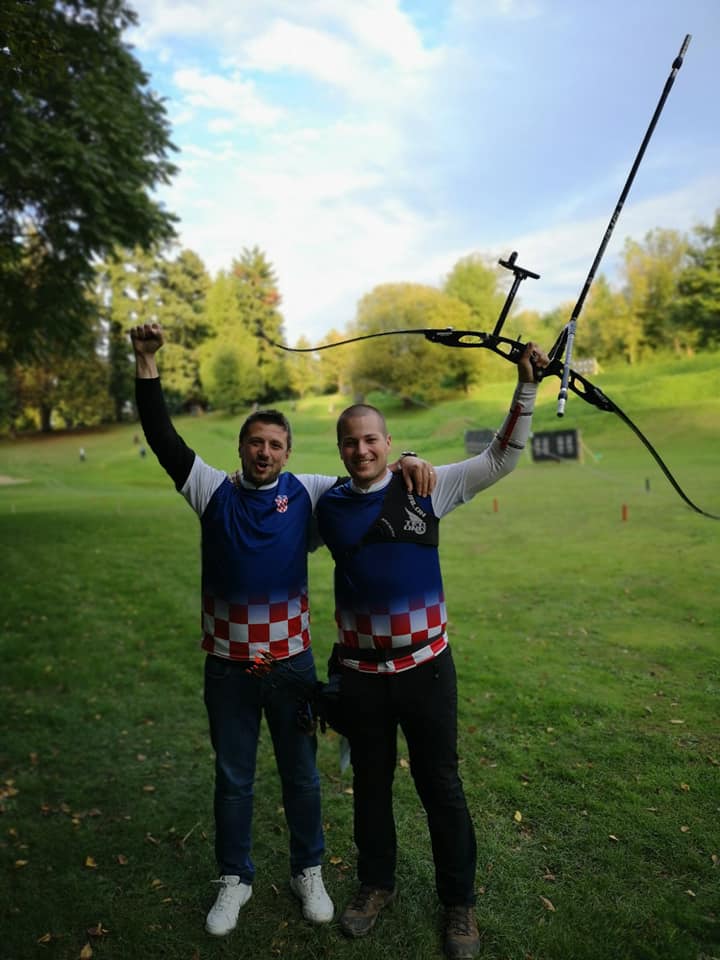
Duels are extremely stressful situations that require a good physical condition and cardio preparation. “People tend to think archery is just ‘pull and shoot’, but the truth is we need to be in excellent both mental and physical shape,” said Lovro, who never imagined that running and push-ups could be so important for archers. When the result is the same, then they shoot the so-called shoot-off, which decides the winner. This is a part of competitions that everyone watches without breathing. “If you’re watching your friend shooting a shoot-off, you want to cheer, but you have to be silent. You could distract both your friend and his opponent, and this would be horribly disrespectful,” said Lovro, who once was shooting against Lee Woo Seok, currently the 2nd in the World Archery [the international federation] ranking.
Archery is a sport made up of details; one wrong breath can cost archers a couple of points, and the same goes with the technicalities. “Even the slightest change in the way you release the string from your fingers can cause problems,” said Lovro, taking another thin arrow for a 70 metre-range from the black quiver. “And the worst thing is, there are so many details that you often aren’t aware of the mistake you’ve been making because your focus is on ten other things.”
This is when the coach steps in. For 42-year-old archery coach from the Grebendgradski streličari, Zoran Marenčić, Lovro has only kind words. “Zoki is like a friend or a big brother to us. We can mess around but also learn a lot from him.” Zoran has been with this small team from the very beginning, so for four years now. “I practice archery in Varaždin, but I’m the coach here. It would be a lot easier for me to be in just one place, but I can’t make up my mind. I love both clubs,” said Zoran, for whom a good atmosphere among his students is way more important than good results. “If I see them struggling at the competition, I always say to them: ‘Listen, kid, you’re here for yourself. Enjoy every arrow, enjoy the feeling. Forget the result. We’re here to have fun.’”
It doesn’t matter what is going around Lovro while he shoots, as long as he is calm and steady inside his own head. “It’s challenging to shoot when it’s raining, because the string gets wet and heavier, which also affects the hit,” said Lovro, looking the target 70 metres away through his binoculars. As he walked to the target to write down the score, he explained how the wind is actually the worst thing. “We have to learn how to shoot in any weather, but shooting when the wind is blowing in one second, then is calm the next, is way harder than it seems.”
Thin, carboned-arrows, which fly through the air like a snake moves on the ground, are meant for large distances [40-70 metres] due to their aerodynamics. Those are only in use during the outdoor season, which starts in March. Since aluminum-arrows need to be thicker and more solid, they are perfect for 18 metres, a distance for the indoor season. As soon as the national competition in September ends, archers start practicing for the indoor season.
Lovro has a problem with big halls because large, closed spaces irritate his eyes. This was a distraction for him when he was shooting in Rome; he constantly kept blinking. “I felt like my eyes were burning when I was trying not to blink at the moment of shooting,” said Lovro, whose father, Ivica, started practicing archery because of him. Now his son teaches archery to him, detail by detail, in the same way Ivica taught Lovro how to make the very first steps.
“I couldn’t be prouder,” said Ivica, who now uses Lovro’s old equipment. “I was with him during almost every competition. Being a witness to his great progress in a couple of years is what every parent wishes for.”
Another one of the memories from the world cup that will remain with him for a while was the robbery. Lovro was returning to his hotel room and scrolling through Facebook when he saw one Croatian archers’ status with photos of their van with broken windows. After that, another status from another archer was published, with the same photos in the post. Someone broke into a couple of archery vans and stole not only all of the equipment [around €2.600 per archer] but also things like pillows, reserve clothes and jackets – it was the middle of December.
Lovro’s team equipment was always with them, in a safe place, so they could be at peace, but the disappointment was present. “I think people don’t even know the value of this. Not only in a materialistic way but also for an archer who was maybe working his ass off for years to have some decent equipment,” said Lovro, squeezing the sponsored cap in his hands.
For the archers who were practicing six days per week, a couple of hours daily, this was an enormous setback. Thw archery teams, especially Slovenian ones, took care of this issue, called their sponsors almost immediately, and got brand new equipment in a short time. But the Croatian archers needed to learn to live with a new daily routine, which included continuously checking their phones for new information about their equipment.
Lovro practices five days per week; usually, twice a day, he rests on Saturday and goes to compete on Sundays. With a regular job in Zagreb and such a rhythm, Lovro doesn’t have much free time. “But I’m okay with that; archery is my free time. Besides, the whole team is my gang. We get along quite well.”
The Grebengradski streličari archery club gathers around fifteen active archers, making up a small team but boasting some great results. Besides Lovro, Adam Gradiščak, a 16-year-old high school student, also took part in the national team. Not to stay only on a national level, in February 2020, Pavle Vujasin broke the world record in his category, Barebow Junior Men.
The feeling Lovro gets when he shoots is effortless – perfect posture, aligned feet at the spacing of the hips, calmness in both body and mind, and those few moments before shooting, knowing he is the one who controls the target panic. “Only then can you be sure your arrow will hit the centre. This feeling is like a drug – once you’ve done it perfectly, you want to do it over and over again.”
As he was picking up his fiberglass black and white bow, Lovro prepared himself for his 70th arrow in this past hour. He took a deep breath, just like in Napoli. Raised his bow, just as he did in Rome. Pulled the string like he did in Nimes. Released the arrow as he did at the European championship. Now he’s home, watching the arrow fly across the green field littered with birch trees along the stream, where pure curiosity made him take up this sport four years ago.

